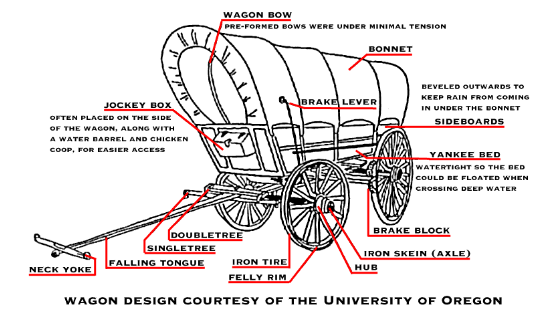Encyclopedia Dubuque
"Encyclopedia Dubuque is the online authority for all things Dubuque, written by the people who know the city best.”
Marshall Cohen—researcher and producer, CNN
Affiliated with the Local History Network of the State Historical Society of Iowa, and the Iowa Museum Association.
COVERED WAGONS
COVERED WAGONS. The covered wagon used to cross the plains to the west was a smaller, lighter version of the big Conestoga wagon used in the east. The cloth top that protected people and possessions from extreme weather conditions was the prime reason that the wagon was sometimes referred to as the "prairie schooner". A frame of hickory bows held the wagon top which could be rolled back for ventilation. Waterproofed with paint or linseed oil, the top was made of heavy duty canvas, often made from hemp. (1)
Big wheels helped the wagon roll easily over bumps and dips in the trail, and wide rims helped keep the wagon from sinking into soft ground. Rear wheels were about five or six feet in diameter, the front ones four feet or less. The front wheels had to be smaller to permit sharp turns--a big wheel would jam against the wagon body. (2)
The wagon's 10 X 3.5 foot body could carry a load of a ton and a half, but most experts advised to keep the weight below this limit. The lighter the wagon, the less likely it was to bog down in muddy stream banks or prairie sloughs--or to exhaust the teams pulling it. Massive axles supported the weight of the wagon body and load. On the plains, a broken axle was a disaster--wagoners usually took along a spare. (3)
Each ox wagon was provided with two extra bows, six S's, and six open links for repairing chains. Every wagon had a tongue, coupling pole, king-bolt and a pair of extra "hounds." Every set of six mule wagons was furnished with five pairs of hames, two double trees, four whipple-trees, and two extra pairs of lead bars. (4)
Two lariats were needed for every horse and mule, as one generally wore out before reaching the end of a long journey. They were found useful in crossing deep streams, in lowering wagons down steep hills and mountains; and repairing broken wagons. (5)
One of the most important articles to the outfit of the prairie traveler was buckskin. For repairing harness, saddles, bridles, and numerous other daily necessity, the awl and buckskin found constant use. (6)
Prairie schooners heading west were a common sight in Dubuque around 1860. The fact that an article in the September 11, 1890 Dubuque Daily Herald stated that two schooners "attracted considerable attention" indicates they were still used. These two wagons were headed back to Wisconsin full of pioneers who had tried homesteading in South Dakota. (7)
---
Source:
1. Flora, Stephanie. "The Covered Wagon," Online: http://www.oregonpioneers.com/wagon.htm
2. Ibid.
3. Ibid.
4. Ibid.
5. Ibid.
6. Ibid.
7. "Returning to Wisconsin," Dubuque Daily Herald, September 11, 1890, p. 4. Online: https://news.google.com/newspapers?nid=_OG5zn83XeQC&dat=18900911&printsec=frontpage&hl=en


